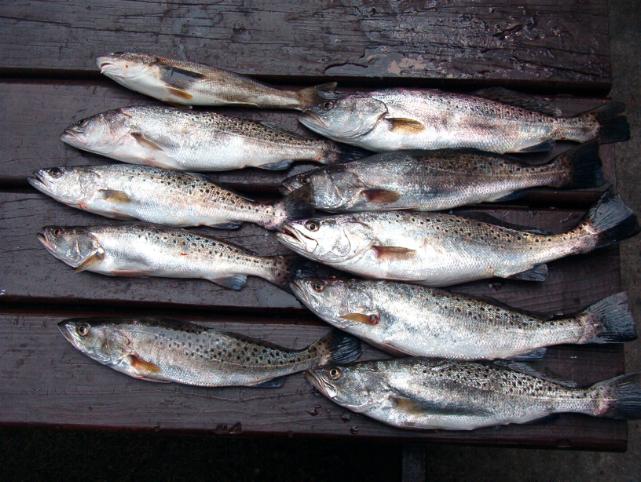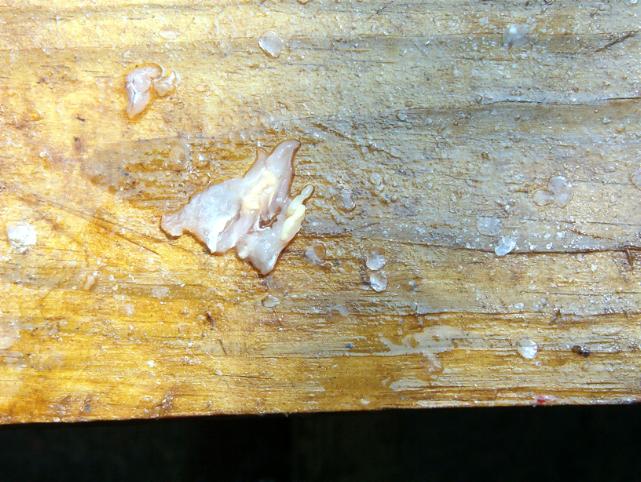Parasites
in Spotted Seatrout
Back
to Main
By: Capt Rick Reynolds
08/13/2005
You
need to pay special attention when you filet your Spotted Seatrout and
be on the watch for parasites that you can easily see.These Trout were
taken in 83° - 84° water in Wassaw sound. These fish were caught
on an incoming tide in about 6 feet of water. I always check my filets
for parasites and found a couple in these fish . See the pictures below
for what the parasite looks like in the filet and cut out of the filet.
Research explains that this is probably known as a "Spaghetti Worm",
an article appears at the bottom of this page of pictures. The article
points out the following: In
general, the saltier the water and the less polluted it is, the higher
the levels of infection are. This may be due to either one of the intermediate
host's or the larval worm's needs for saline, unpolluted waters.

Notice the yellow colored mass embeded in this filet. I am pointing to it with the tip of my filet knife. Usually you will find more that one parasite but this is the only one on this fish.

Notice the size of the parasite after I cut it out of the filet for this picture. I think it was actually 2 small parasites in 1 area of the fish.

The
following article was copied from the following website
: http://www.seagrantfish.lsu.edu/about/index.html
SPAGHETTI WORMS IN FISH
Spaghetti worms are common parasites of saltwater fish in the drum family, which include speckled and white trout, black drum, redfish, and croakers. While they look alike to most fishermen, several different worms use these fish as hosts. Most common in sea trout is Poecilancistrium caryophyllum. Worms found in black drum are most often Pseudogrillotia pIeistacantha. For ease of discussion, we will dispose of these tongue-twisting Latin names and refer to them all as spaghetti worms.
Fishermen frequently find these white, one to three inch long worms when filleting their catch. In trout they are usually found in the middle of the fillet in the area just below the dorsal fin. Research has shown that approximately 40% of Louisiana and Mississippi speckled trout are host to spaghetti worms, with an average of between one and two worms occurring per fish. It may appear that many more worms exist, but often one worm is cut into several pieces during filleting. Spaghetti worms in black drum are more common near the tail of the fish with a typical fish hosting 5 to 15 specimens.
The spaghetti worms we see in these fish are really parasitic tapeworms of sharks, who are just using the trout or drum as an intermediate host. The cycle begins with eggs produced by an eight-inch long adult worm which lives in a shark's intestine. After being passed into seawater, the egg hatches into a tiny swimming larva called a coracidium. If this larva is eaten within two days by a small marine crustacean like a copepod, it develops into another stage called a procercoid.
At this stage some uncertainty exists as to what happens. The copepod may be eaten by a trout, passing the larval worm on the trout. However, since small animals like copepods are seldom eaten by larger trout and since very few trout under ten inches long have spaghetti worms, another host is suspected. More than likely, a small bait fish like an anchovy eats the copepod and it in turn is eaten by the larger trout. In any case, once the larval worm is in the trout's digestive tract, it tunnels its way into the trout's flesh where it may live for several years. The life cycle is completed when a shark eats the trout and serves as host for the adult worm.
The fact that a spaghetti worm may live several years (up to 6 or 7) may surprise many fishermen, since they often claim that more fish are infected in one season than another. This may possibly be due to different populations of trout with different infection rates, moving up and down in a marsh system seasonally.
The number of trout carrying worms seems to be directly related to the characteristics and quality of the water in which the trout live. In general, the saltier the water and the less polluted it is, the higher the levels of infection are. This may be due to either one of the intermediate host's or the larval worm's needs for saline, unpolluted waters.
Another interesting fact is that once a trout becomes host to one or several spaghetti worms, it seems to develop an immunity to further infections. If this were not the case, large, old fish would have many more worms than a 12- or 14-inch fish, but they don't.
Finally, while the spaghetti worm may be somewhat unappealing to the eye, it certainly doesn't prevent good eating. Since, they are large enough to easily see, they are simple to remove during the filleting process. Simply grab the worm between the knife blade and thumb and gently pull it out. With a little practice, it becomes easy.
Many people don't even bother to remove them before cooking. After cooking, they are unnoticeable and cannot be tasted. In a survey conducted at Mississippi fishing rodeos a few years ago, less than 25% of the trout fishermen avoided eating fish with worms.
While cooking does, of course, kill the worm, even without cooking they are not a human health problem. No human infections have been recorded and researchers have been unable to infect warm-blooded animals with the parasite.
So good fishing and "bon appetit.”
Copyright © 2008 Thunderboltcharters All Rights Reserved.